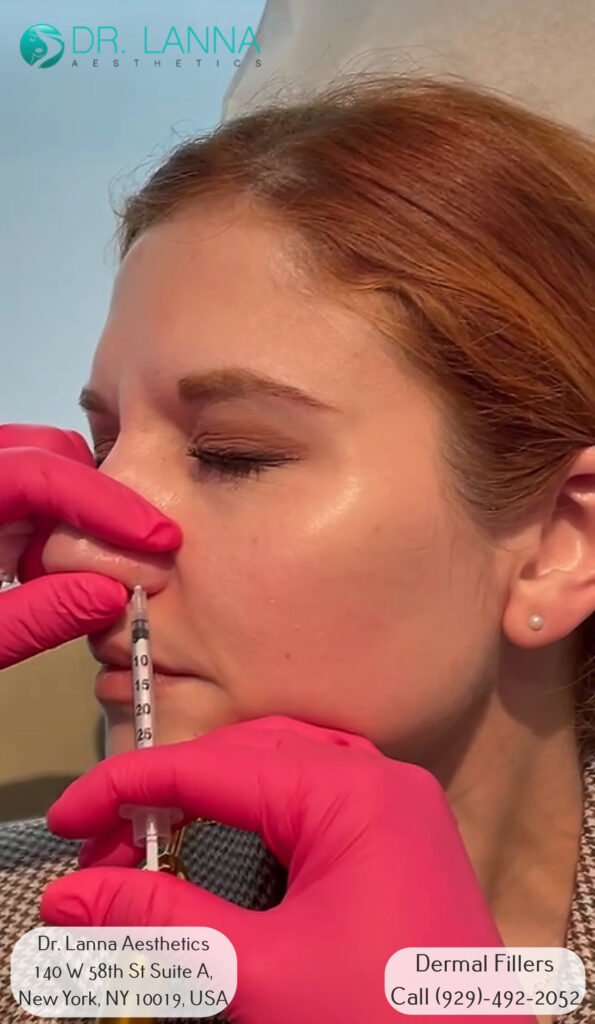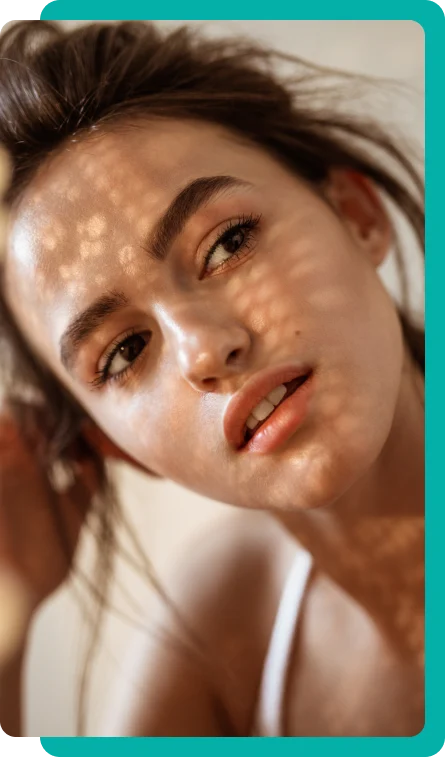Age is one of the main factors to older-looking skin, but temporary dermal fillers can be the answer. Temporary dermal fillers are not permanently fixed and can be adjusted to suit your natural facial changes over time.
So how long do temporary dermal fillers last? A single treatment can last for 6 to 12 months – sometimes even longer depending on different factors like filler placement and stress. For longevity, it’s best to pick a trusted and credible aesthetic provider.
The Longevity of Temporary Dermal Fillers
A single dermal filler treatment can give instant results. Although results are temporary, some of the newest dermal fillers on the market can last as long as two years! The results vary with each individual and are based on numerous factors (e.g., age, health conditions, lifestyle, skin type, sun exposure, brand, and amount of filler).
Types of Temporary Dermal Fillers
1. Hyaluronic Acid Filler
Hyaluronic acid (HA) is the most commonly used base for dermal filler treatments. HA is a naturally occurring enzyme found in your body and has high concentrations in the skin, joints, and eye sockets. Essentially, it traps water molecules from facial products, therefore keeping the skin hydrated and plump. Such dermal fillers are usually used to fill out wrinkles, the nasolabial fold, and lost facial volume.
This type of filler typically lasts for 6 to 12 months and, in some cases, even longer depending on your body’s metabolism. Repeated facial injections could enhance its effects and even train your body to respond better to the substances the next time around.
Some FDA-approved HA fillers include:
- Juvéderm products: Juvéderm XC, VOLUMA, VOLBELLA, VOLLURE
- Restylane products: Restylane, Restylane Silk, Restylane Lyft, Restylane Refyne, Restylane Defyne, Restylane Kysse, Restylane Contour
- Belotero Balance
2. Collagen-based Filler
The collagen protein is abundant in the dermis layer of our skin (beneath the epidermis). It, essentially, acts as a support structure. Over time, the structure weakens every time you smile, frown, squint, or just simply any facial expression that stresses the collagen in your skin. Hence, fine lines begin to appear on your face.
Collagen injectable fillers, also known as soft-tissue augmentation, stimulates your body’s natural collagen production, especially in areas where the protein has depleted. That’s why it is used to fill out skin depressions and reduce the appearance of scars.
Although the results of a collagen filler injection is temporary (lasts up to 5 years), they cannot be reversed easily. You may also need touch-ups every 3 to 12 months to maintain the youthful look. Take note, however, that this cosmetic procedure stimulates collagen production amounts differently per individual and so the time in between touch-ups may be longer for others.
Some brand names are Bellafill, CosmoDerm, CosmoPlast, Zyderm, and Zyplast. Sculptra Aesthetic, on the other hand, is a collagen stimulator which uses poly-L-lactic acid (PLLA) as its base. Sculptra can last 2 to 5 years.
3. Calcium Hydroxylapatite Fillers
Also a collagen stimulator, calcium hydroxylapatite (CaHA) is primarily found in our bones and teeth. It also works wonders for facial sculpting. This type of filler is known for filling deep nose to mouth lines, as well as wrinkles. But note that it’s not applied to the lip area.
CaHA fillers are gel-like, thicker than that of HA fillers. Results can last for approximately 12 months. Calcium hydroxylapatite is the main ingredient of the brand Radiesse.
Factors That Affect the Longevity of Dermal Fillers
1. Skin Damage
First of all, your skin type can be based on your age and lifestyle. To keep your skin moisturized, you would need to do water therapy, most especially if you have HA-based fillers and want to enhance its effects.
You should also religiously follow your skincare routine to promote filler longevity. In addition, sun damage is a common factor for aging skin. Should you need to go outdoors, wear a daily sunscreen of SPF 45 and wear protective clothing.
2. Hollows
Whenever you have hollows in the face, such as in the temples, you may need more product. This can get quite expensive should you need combination treatments and additional touch-up appointments.
3. Placement
The area of concern, depth, and amount of filler affects your results’ longevity. Dermal fillers also tend to last longer in areas where there is less facial movement.
4. Stress
While stress-inducers can be difficult to avoid, they accelerate the aging process. You may find it beneficial to do stress relief techniques (e.g., yoga and meditation) and low-impact exercises. You’ll find that not only will you feel calmer, but you’ll also extend your filler’s results.
5. Expectations
Always manage your expectations. Say, for instance, you’re asking for a very high cheek and thus expect a lot of filler. As the filler wears off, results fade, and aging continues, you would need to frequently visit the doctor for touch-ups.
How to Make Temporary Dermal Fillers Last Longer
1. Pre-Procedure Care Tips
It goes without saying, but you’re going to make a commitment to yourself when getting dermal fillers. These are some reminders to before your filler treatment:
- Do your research: Read articles from reputable sites and be fully aware of all the risks that come with dermal filler treatments.
- Ensure that you’re a suitable candidate: Dermal fillers are not suitable for those who are pregnant, breastfeeding, and those prone to bruising. Inform your consultant about your medical history, skin type, and any allergies.
- Ask for a consultation: It’s only a given that this is a cosmetic procedure where you want to come out satisfied with the results. Be crystal clear about your goals. Ask all your questions.
- Take pain relief medications like Tylenol: Unless recommended otherwise, you may want to take some pain relief medication if you’re nervous about any discomfort.
- Know what to avoid: Aspirin, NSAIDs, dental procedures, exercise, and alcohol consumption are only a few examples.
- Come to the appointment with a clean face: Do not put on any moisturizer or make-up products.
2. Post-Procedure Care Tips
You can expect a few things right after your procedure: redness, bruising, tenderness, swelling, and small lumps. These usually fade away in 4 weeks at most. Now it’s not just the filler that determines how long your results last. It’s also you – your choices, habits, and routines.These are a few aftercare tips that you should do to maximize results:
- Use ice or the topical cream Arnica to reduce swelling
- Don’t touch or pick at the injection points (don’t worry, the itching will go away after 24 hours)
- Avoid drinking alcohol, or applying any skincare products or makeup for the rest of the day following treatment
- Don’t book a flight for 3 days
- Don’t engage in intense physical exercise
- Sleep on your back to prevent dispersing the product
- Drink lots of water
- Wear daily sunscreen
- Apply only clinically-proven skincare products
- Regular touch-up visits
If you notice the onset of any of the following symptoms, call a doctor immediately: discoloration of injected areas, large bruises, increasing pain, severe swelling, blisters, difficulty swallowing or smiling, fever, or chills.
Additional Treatments and Maintenance
1. Follow-Up Appointments and Touch-Ups
As mentioned, dermal filler results can last for 6 months to as many as several years. Routine touch-ups extend its results seamlessly. Meanwhile, how often you should get filler injections depends on your specific filler and aesthetic goals.
Hyaluronic acid fillers, like Juvéderm and Restylane, typically last for 6 to 18 months. To maintain your results, you may want to have a touch-up every 4 to 12 months. While other fillers like Radiesse and Sculptra can last up to 2 years, maintenance treatments are needed less often because these brands are usually used for more severe volume loss.
2. Combine With Other Treatments
As they say, two is better than one – the same goes for dermal filler treatments. Before visiting your plastic surgeon, ask yourself “What do I really want out of the experience?”. You have to make sure that your expectations are realistic given your chosen cosmetic treatment.
It can sometimes be necessary to combine cosmetic procedures to achieve your aesthetic goals. You may end up spending more time in the office and pay significantly higher costs. If you’re up for it, here are possible combinations to temporary fillers that can significantly improve your results:
3. Botox
Botox and dermal fillers complement each other nicely because each product targets a different issue. Dermal filler injections are usually used for static wrinkles that occur when hyaluronic acid levels diminish especially on the middle and lower areas of the face, restoring volume and softens the appearance of such creases.
As for Botox, its strengths lie in its ability to relax muscle activity wherever injected, especially areas with dynamic wrinkles. Aside from reducing the formation of lines and wrinkles, it can minimize the appearance of crow’s feet and frown lines. In addition, it’s typically injected around the eyes and forehead.
Using Botox and dermal fillers in conjunction can not only give you a youthful and restful appearance, but it can also prolong your results — since hyaluronic acid breaks down fast in areas that are animated, injecting Botox can relax facial muscles and thus the enzyme would break down at a slower rate.
4. Laser
Patients often request either for fillers or laser resurfacing, yet optimal results are obtained when these two are combined. This is because most laser treatments don’t penetrate the skin as deeply as an injectable filler. Having laser treatment first, followed by fillers, is the recommended sequence. There is usually a 1 to 2 week break in between treatments to give your body time to heal and wait for any swelling to subside.
5. Thread Lifts
With a thread lift, the doctor uses a dissolvable suture right below the skin’s surface to pull back and reposition loose skin. It’s non-surgical, minimally invasive, and can be performed in one session. Combine it with a facial filler, and you might look like you got a liquid facelift.
If you want to puff up your cheeks, you can opt for a dermal filler like Voluma; however, you wouldn’t be addressing the sagging skin underneath. A thread lift physically lifts the skin and angles it upward. You’ll come out of the doctor’s office with a tighter and younger-looking face.
Try Our Facial Rejuvenation Treatments at Dr. Lanna Aesthetics
It might be best to try temporary solutions before committing to a permanent filler – or even plastic surgery – so that you can get an idea of what aesthetic goals you want in the long run. Temporary dermal fillers are best obtained through Dr. Lanna Aesthetics.
Wherever you are in your beauty journey, our team of expert and qualified injectors guarantees that we’ll figure out the best procedure and maintenance plan for you. Enhance your beauty and let us help you feel more confident by contacting us today at (929) 565-7539.



